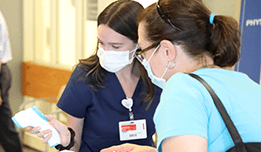Caring for Yourself
Focusing on the health and well-being of your newborn is natural. However, new mothers must take special care of their bodies after giving birth and while breastfeeding. Throughout your stay at NewYork-Presbyterian, our team will provide information and training on how to care for yourself. Some of the information covered includes:
After delivery
Your body will go through many changes after giving birth. Common issues include:
- Hemorrhoids: Hemorrhoids are common during pregnancy. For some moms, hemorrhoids persist after childbirth. Ice packs and witch hazel pads can provide comfort. Also soaking your bottom in warm water in a tub or small plastic basin (a sitz bath) helps relieve pain.
- Menstruation: Your period may begin within four to six weeks of delivery. In some cases, particularly in breastfeeding moms, you may not experience a period for several weeks or months. It’s recommended new moms should use sanitary napkins—no tampons—for the first six weeks.
- Sex and family planning: It is recommended couples wait four weeks before having vaginal sex. It's also important to note—it’s hard to know when ovulation and menstruation will begin after delivering your baby. If you do plan to have sexual relations, please speak with your health care provider about what method of family planning is best for you.
- Uterine involution: You may feel contractions after you deliver—which is due to your uterus working to return to its pre-pregnant state. Breastfeeding mothers may experience worsened contractions during and after feeding.
- Vaginal bleeding: After a vaginal birth, you will likely have vaginal discharge that is red in color. Over the next four to six weeks, this discharge will turn from red to pink to white. Bleeding may increase with breastfeeding or physical activity. It is recommended to use liners or sanitary napkins, not tampons, if you experience bleeding.
- Vaginal soreness: It’s normal to feel pain, discomfort, and numbness, after vaginal birth. This soreness may worsen if you had a perineal tear—a cut made by the doctor or midwife of the area between the vagina and anus to help deliver the baby and prevent muscle tearing.
- Cesarean section: If you had a cesarean birth, the doctor might close your incisions with internal stitches that will dissolve by themselves. If staples were used, they might be removed before you go home or your physician may have you turn to their office for removal during the first week after delivery. After the staples are removed, small pieces of tape are placed over the incisions. These will curl up and fall off by themselves.
Things to look out for
Call your doctor or come to the emergency room if you have:
- Increased bleeding or clots larger than a quarter
- Foul-smelling vaginal discharge
- Fever of 101 degrees or higher
- Increased pain
- Swollen, red, tender areas on the breasts
- Severe headaches, blurred vision, or extreme swelling of the hands or feet
- Difficulty or burning during urination
If you had a cesarean section, contact your doctor if you notice any of these changes in your incision:
- Bleeding
- Opening up
- Increased pain
- Drainage
- Redness or swelling
For more information, please consult with your doctor’s office.



